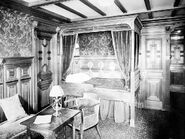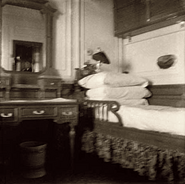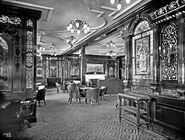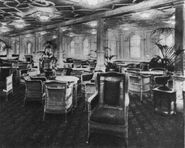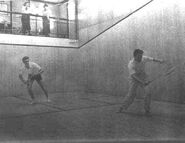First Class, often called 'saloon' on other liners, was the most luxurious and expensive class of the Titanic. Those in First Class ranged from wealthy businessmen, engineers, physicians, socialites, the servants of the wealthy, and much more. First Class on the Titanic and her sister ship, the RMS Olympic, were considered superior to other ocean liners due to their lavish accommodations, size, and elegant designs. While Second and Third Class aboard the Titanic were outstanding for their price, First Class was on another level.
First Class Accommodations by Deck[]
Boat Deck[]
The Boat Deck was the topmost deck aboard the Titanic and was where the lifeboats and Bridge were located. Indoor spaces on this deck were primarily for crew members or machinery, but for First Class passengers there were six staterooms, lettered T, U, W, X, Y, and Z. There was one bathroom for the use of all of these cabins. All of these cabins fitted one passenger each, minus cabin Z, which had room for two. Aft to the cabins was the Grand Staircase. The Grand Staircase had three elevators, manned by the lift attendants, for use of First Class passengers, and also contained a beautiful dome. The stairs and elevators could take passengers up to the Boat Deck and lead down to E-Deck. Also on the Boat Deck was the Gymnasium, where passengers could exercise for a fee of one shilling at the Enquiry Office on C-Deck. The Gymnasium was open from 9 A.M. to 6 P.M., but the time in which it could be used depended on the gender of the passenger - ladies in the morning, children during mid-day, and gentlemen in the afternoon. The final amenity for First Class passengers on the Boat Deck was the Promenade. The Promenade on the Boat Deck was uncovered, unlike its counterpart on A-Deck. On the Promenade, passengers could walk around, enjoy views of the sea, socialize, play deck games, and lounge around in deck chairs. The Promenade began at the davits of lifeboats 3 and 5 on the starboard side, and the davits of boats 4 and 6 on the port side - the Officer's Promenade was in front of the First Class Promenade. It then ended at the Third Funnel, with the Engineer's Promenade behind it.
A-Deck[]
Besides the Second Class Staircase and elevator, all of A-Deck was occupied by amenities and staterooms for those in First Class. Compared to the Boat Deck, A Deck had much more staterooms, 34 towards the bow, and 2 towards the stern. The majority of these cabins only had one bed, however, six staterooms, A-3, A-4, A-34, A-35, A-36, and A-37, had room for three passengers each. There was no A-13 due to 13 being considered unlucky. None of the staterooms towards the bow had a private bathroom. Instead, there was a men's and ladies' lavatory, and five private baths. The private baths must be booked and reserved with the deck's bathroom steward. However, the two staterooms towards the stern, A-36 and A-37, had full private bathrooms. Similar to the Boat Deck, A-Deck also had a Promenade. However, the A-Deck Promenade was just for First Class use only and was fully covered from the elements. Going aft down a hallway connected to the Grand Staircase, the Reading and Writing Room was to the left, and the First Class Lounge was straight ahead. The Reading and Writing Room was considered a retreat for primarily women - men could still access the room - where they could relax, socialize, write letters and postcards, and read novels. The Lounge was similar to the Reading and Writing Room, but it was more popular and was used by both men and women. In addition to reading, relaxing, and writing, passengers could order snacks, coffee, tea, or alcoholic beverages from the lounge stewards. The Lounge was also one of the spots where the Band commonly performed concerts. Connected to the Lounge by a hallway, was the Aft Grand Staircase. The Aft Staircase was a smaller, but no less outstanding than, the Grand Staircase. However, the Aft Grand Staircase did not have any elevators and only went from A-Deck to C-Deck. Coming off of the Aft Grand Staircase was the First Class Smoke Room. The Smoke Room was only for adult male passengers. It was here that many would go throughout the day to play cards, drink alcoholic beverages, smoke, relax, and discuss current events. The final two rooms for the use of First Class passengers on A-Deck were the Verandah Cafe and Palm Courts. There were two of these Cafes; one on the port side, and one on the starboard side. Both rooms were identical and had sliding glass doors that opened up to the Promenade. The cafes were decorated to resemble sidewalk cafes. Both cafes served light refreshments. The one main difference was the port Verandah Cafe allowed smoking and was connected to the Smoke Room. The starboard side did not allow smoking. Both sides were used by the passengers, but the starboard side often found more business. The port side cafe would become somewhat of a playroom for First Class children.
B-Deck[]
The outside deck space for First Class passengers was almost completely gone when going down to B-Deck. However, a very small Promenade was located at the front of the deck. Towards the bow of B-Deck, there were 49 staterooms - there was no B-13. The number of passengers that could occupy a stateroom in this area varied between one, two, and three people. None of the staterooms in the bow had private bathrooms. Instead, there was a lavatory for gentlemen and another for ladies, along with six private baths. Aft to the cabins, there was the Grand Staircase, and two entrances for First Class passengers to board and exit the Titanic, one on the starboard side, and another on the port. Near the Grand Staircase were the two most expensive suits on the Titanic: B-51/53/55 and B-52/54/56. These two suits were made up of three rooms, one of which was a sitting room, two bedrooms that could hold two people each, two closets, a full private bathroom, and a private promenade deck. Going astern, there were more First Class cabins. In total, there was an additional 45 cabins. Some of these rooms also had access to private or shared full bathrooms. If the staterooms did not have access to these bathrooms, they would have to use the ladies and gentlemen's lavatories, and go towards the bow if they wished to take a bath - there were no extra baths in this area. The staterooms would end once one reached the Aft Grand Staircase, which, on B-Deck, was considered the reception for the À la Carte Restaurant and the Café Parisien. The À la Carte Restaurant was an alternative dining spot to the First Class Dining Saloon on D-Deck. However, unlike the Dining Saloon, passengers would have to make reservations for a table and pay extra money for food and drinks. On the other hand, passengers could eat whenever they'd like in the À la Carte Restaurant between 8 A.M. to 11 P.M, while they had to attend meals at set times in the Dining Saloon. The À la Carte Restaurant served French cuisine and was considered one of the nicest rooms aboard the whole ship. The Café Parisien was styled to look as if it were a street café in Paris, France. The Café served refreshments and alcoholic beverages, along with French snacks and desserts. The À la Carte Restaurant and Café Parisien was made up of their staff, handpicked by the owner of the À la Carte Restaurant, Luigi Gatti, called the Restaurant Crew. The food and beverages for both were prepared in the same kitchen, also on B-Deck.
C-Deck[]
When it came to C-Deck, the First Class areas were primarily made up of staterooms, lavatories, and private and public baths. In total, there were 147 staterooms on C-Deck - there was no C-13. The majority of the cabins could contain either two or three passengers, but some could only contain one. C-Deck also contained two of the most expensive suits on the Titanic; C-55/57 and C-62/64. The two-room suits contained a bedroom for two people, a sitting room, and a closet, and shared a full bathroom with the cabins next to them - C-59 and C-64. Besides staterooms and bathrooms, First Class passengers could also, of course, use the Grand and Aft Grand Staircase, along with the three elevators. Within the Grand Staircase was the Enquiry Office and First Class Purser's Office. At the Enquiry Office passengers could ask the clerks any questions they have about the locations of rooms aboard the Titanic, buy tickets for the Gymnasium, Swimming Pool, Turkish Baths, Squash Court, and more. The Purser's Office is where passengers can store their valuables in a safe and secure location. C-Deck was also the end of the Aft Grand Staircase. For the servants of First Class passengers, the Maid's and Valet's Saloon was on C-Deck near the Aft Grand Staircase. This is where the maids, governesses, valets, manservants, and other employees of the wealthy would eat their meals instead of the Dining saloon or À la Carte Restaurant.
D-Deck[]
Towards the bow of D-Deck, there were 49 First Class staterooms - there was no D-13. The majority of these rooms held three passengers, but there were multiple that held either one or two. None of these rooms had private bathrooms. Instead, there was a public gentlemen's and ladies' lavatory, and eight baths which could be booked reserved with the deck's bathroom steward. Similar to B-Deck, there were two entrances for First Class passengers to board and exit the Titanic in the Grand Staircase, one on the starboard side, and another on the port. The D-Deck level of the Grand Staircase's foyer was called the Reception Room. The Reception Room is where passengers would wait, socialize, and have the chance to look over menus before each meal in the First Class Dining Saloon, which was right next to it. The First Class Dining Saloon was the largest room on the Titanic at 114 feet long and 92 feet wide, or 10,448 square feet. The Dining Saloon could seat 554 passengers, possessing 115 tables. Breakfast started at 8 A.M. and ended at 10, lunch began at 1 P.M. and ended at 3, and dinner started at 7 P.M. On Sundays, this is where passengers would have church services.
E-Deck[]
E-Deck was the last Deck where First Class staterooms were located. Staterooms E-200, E-201, E-202, and E-203 were counted as First Class staterooms on all voyages and could contain four people each. None of these cabins contain private bathrooms; occupants had to use public lavatories to go to the restroom, and a public, bookable bath. On the Titanic's maiden voyage, staterooms E-1 through E-42, there was no E-13, were considered First Class rooms. However, on other voyages where there was an influx of Second Class passengers to the point where all the permanent Second Class cabins were booked, these rooms could be given to Second Class passengers. On the other hand, rooms E-43 to E-88 were considered Second Class cabins for the Titanic's maiden voyage. However, if there was an influx of First Class passengers to the point where permanent First Class staterooms were all booked, these rooms could be given to First Class passengers. None of the cabins on this deck had private bathrooms. E-Deck was also where the Grand Staircase and its three elevators ended.
F-Deck[]
F-Deck was the final deck First Class passengers had access to. There were no staterooms or bathrooms for First Class passengers on F-Deck, only amenities. In the bow of the ship, there was the Squash Racquet Court. The actual court was two decks tall; it went down to G-Deck, but seeing as there were no exits to the court on G-Deck, they couldn't access the deck. In the Squash Racquet Court, passengers could play against each other, or get tips from the instructor, Fredrick Wright. Equipment to play was provided, but passengers were not expected to have their own. To play Squash for half an hour, cost two shillings, which would be paid at the Enquiry Office on C-Deck. Another feature of the Squash Racquet Court was the Spectator's Gallery, where passengers could watch others play. The Squash Racquet Court could be accessed by a staircase that starts on D-Deck. Also on F-Deck were the Swimming Pool and Turkish Baths. The rooms for these two activities were next to each other near the first funnel's casing. Both also cost four shillings each to use. The Turkish Baths consisted of dressing rooms, a cooling room, a hot room, a temperate room, a sauna/steam room, two shampooing rooms, and an electric bathtub. Five Turkish Bath attendants oversaw the use of the rooms. The bottom of the Swimming Pool reached down to G-Deck. The pool was made up of heated salt water. The Swimming Pool area also had thirteen dressing rooms, and two showers for after using the Pool. Only women could use the rooms in the morning, and only men could use them in the afternoon. These rooms could be accessed by a staircase starting on D-Deck.
Pictures[]
First Class Passenger List[]
Here is a list of the 324 First Class passengers on the RMS Titanic.
A-F[]
- Elisabeth Walton Allen
- Hudson Joshua Creighton Allison
- Bess Waldo Allison
- Helen Loraine Allison
- Hudson Trevor Allison
- Harry Anderson
- Thomas Andrews (H&W Guarantee Group)
- Cornelia Theodosia Andrews
- Charlotte Appleton
- Ramon Artagaveytia
- John Jacob Astor
- Madeleine Talmage Astor
- Léontine Pauline Aubart
- Ellen Mary Barber
- Algernon Henry Barkworth
- Albina Bassani
- John David Baumann
- Hélène Baxter
- Quigg Edmond Baxter
- Thomson Beattie
- Richard Leonard Beckwith
- Sarah Maybell Beckwith
- Karl Howell Behr
- Nellie Mayo Bessette
- Rosalie Bidois
- Ellen Bird
- Jakob Birnbaum
- Dickinson H. Bishop
- Helen Margaret Bishop
- Mauritz Håkan Björnström-Steffansson
- Stephen Weart Blackwell
- Henry Blank
- Caroline Bonnell
- Elizabeth Bonnell
- John James Borebank
- Grace Scott Bowen
- Elsie Edith Bowerman
- John Bertram Brady
- Emil Franklin Brandeis
- George Arthur Brereton
- Arthur Jackson Brewe
- Caroline Lane Brown
- Margaret Brown
- Emma Eliza Bucknell
- Elizabeth Margaret Burns
- Archibald Willingham Butt
- Alexander Milne Cairns
- Edward Pennington Calderhead
- Helen Churchill Candee
- Charlotte Wardle Cardeza
- Thomas Drake Martinez Cardeza
- Frans Olof Carlsson
- Francisco Mauro Carrau
- José Pedro Carraú-Esteves
- William Ernest Carter
- Lucile Carter
- Lucile Polk Carter
- William Thornton Carter II
- Howard Brown Case
- Eleanor Geneviene Cassebeer
- Tyrell William Cavendish
- Julia Florence Cavendish
- Herbert Fuller Chaffee
- Carrie Constance Chaffee
- Norman Campbell Chambers
- Bertha Chambers
- Victorine Chaudanson
- Gladys Cherry
- Paul Romaine Marie Léonce Chevré
- Edith Martha Bowerman Chibnall
- Roderick Chisholm (H&W Guarantee Group)
- Walter Miller Clark
- Virginia Estelle Clark
- Alice Catherine Cleaver
- George Quincy Clifford
- Edward Pomeroy Colley
- Mary Eliza Compton
- Sara Rebecca Compton
- Alexander Taylor Compton Jr.
- Malvina Helen Cornell
- John Bertram Crafton
- Edward Gifford Crosby
- Catherine Elizabeth Crosby
- Harriette Rebecca Crosby
- John Bradley Cumings
- Florence Briggs Cumings
- Peter Dennis Daly
- Robert Williams Daniel
- Sarah Daniels
- Thornton Davidson
- Orian Davidson
- Albert Adrian Dick
- Vera Dick
- Washington Dodge
- Ruth Dodge
- Washington Dodge Jr.
- Walter Donald Douglas
- Mahala Douglas
- Mary Hélène Douglas
- Cosmo Edmund Duff Gordon
- Lucy Christina Duff Gordon
- William Crothers Dulles
- Olive Earnshaw
- Caroline Louise Endres
- Elizabeth Mussey Eustis
- Edith Corse Evans
- John Farthing
- Antoinette Flegenheim
- Margaret Fleming
- John Irwin Flynn
- Benjamin Laventall Foreman
- Mark Fortune
- Mary Fortune
- Ethel Flora Fortune
- Alice Elizabeth Fortune
- Mabel Helen Fortune
- Charles Alexander Fortune
- Laura Mabel Francatelli
- Thomas Panham Franklin
- Isaac Gerald Frauenthal
- Henry William Frauenthal
- Clara Frauenthal
- Hedwig Margaritha Frölicher
- Maximilian Josef Frölicher-Stehli
- Margaretha Emerentia Frölicher-Stehli
- Richard Thomas Fry
- Jacques Heath Futrelle
- Lily May Futrelle
G-M[]
- Arthur Gee
- Pauline Caroline Gibson
- Dorothy Winifred Gibson
- Amalie Henrietta Gieger
- Victor Gaitan Andrea Giglio
- Samuel Levi Goldenberg
- Nella Carlynne Goldenberg
- George B. Goldschmidt
- Archibald Gracie IV
- George Edward Graham
- Edith Graham
- Blanche Greenfield
- William Bertram Greenfield
- Benjamin Guggenheim
- George Achilles Harder
- Dorothy Harder
- Henry Sleeper Harper
- Myra Raymond Harper
- Henry Charles Harrington
- Henry Burkhardt Harris
- Irene Harris
- William Henry Harrison
- Hammad Hassab
- Walter James Hawksford
- Charles Melville Hays
- Clara Jennings Hays
- Margaret Bechstein Hays
- Christopher Head
- Herbert Henry Hilliard
- William Henry Hipkins
- Ida Sophia Hippach
- Gerturde Isabelle Hippach
- Anna Louisa Hogeboom
- Alexander Oskar Holverson
- Mary Alice Holverson
- Harry Haven Homer
- Frederick Maxfield Hoyt
- Jane Anne Hoyt
- William Fisher Hoyt
- Rose Amélie Icard
- Ann Elizabeth Isham
- Joseph Bruce Ismay
- Charles Cresson Jones
- Henry Forbes Julian
- Edwin Herbert Keeping
- Edward Austin Kent
- Frederick Roland Kenyon
- Marion Estelle Kenyon
- Edwin Nelson Kimball
- Susan Gertrude Kimball
- Herman Klaber
- Emilie Kreuchen
- Alice May Leader
- Berthe Leroy
- Louis Gustave Joseph Lesueur
- Ervin G. Lewy
- Erik Gustaf Lind
- Sigrid Lindström
- Elizabeth Lindsey Lines
- Mary Conover Lines
- Milton Clyde Long
- Gretchen Fiske Longley
- Joseph Holland Loring
- Eugénie Elise Lurette
- Georgette Alexandra Madill
- John Edward Maguire
- Roberta Elizabeth Mary Maioni
- Pierre Maréchal
- Daniel Warner Marvin
- Mary Graham Carmichael Marvin
- Berthe Antonine Mayné
- Thomas Francis McCaffry
- Timothy John McCarthy
- James Robert McGough
- Edgar Joseph Meyer
- Leila Meyer
- Francis Davis Millet
- William Edward Minahan
- Lillian Mae Minahan
- Ida Daisy Minahan
- Philipp Edmund Mock
- Harry Markland Molson
- Clarence Moore
N-S[]
- Charles Natsch
- Arthur Webster Newell
- Majorie Anne Newell
- Madeleine Newell
- Helen Monypeny Newsom
- Arthur Ernest Nicholson
- Alfred Nourney
- Fermina Oliva y Ocana
- Engelhart Cornelius Østby
- Helene Ragnhild Østby
- Servando José Florentino Oviés y Rodríguez
- William Henry Marsh Parr (H&W Guarantee Group)
- Austin Partner
- Vivian Ponsonby Payne
- Thomas Pears
- Edith Pears
- Victor Peñasco y Castellana
- Maria Josefa Perezde Soto y Vallejo Peñasco y Castellana
- Mary Anne Perreault
- Arthur Godfrey Peuchen
- Walter Chamberlain Porter
- Lily Alexenia Potter
- Manuel Uruchurtu Ramírez
- Johan George Reuchlin
- George Alexander Lucien Rheims
- Sante Righini
- Elisabeth Walton Robert
- Victor Robins
- Washington Augustus Roebling II
- Charles Hallace Romaine
- Hugh Roscoe Rood
- Edith Louise Rosenbaum
- George Rosenshine
- John Hugo Ross
- Lucy Noël Martha Rothes
- Martin Rothschild
- Elizabeth Jane Anne Rothschild
- Alfred G. Rowe
- Arthur Larned Ryerson
- Emily Maria Ryerson
- Emily Borie Ryerson
- Susan Parker Ryerson
- John Borie Ryerson
- Adolphe Saalfeld
- Emma Sägesser
- Abraham Lincoln Salomon
- Emma Schabert
- Augusta Jeanne Serreplaà
- Frederic Kimber Seward
- Elizabeth Weed Shutes
- Spencer Victor Silverthorne
- William Baird Silvey
- Alice Gray Silvey
- Alfons Simonius-Blumer
- William Thompson Sloper
- John Montgomery Smart
- James Clinch Smith
- Richard William Smith
- Lucian Philip Smith
- Mary Eloise Smith
- John Pillsbury Snyder
- Nelle Snyder
- Frederic Oakley Spedden
- Margaretta Corning Spedden
- Robert Douglas Spedden
- William Augustus Spencer
- Marie-Eugénie Spencer
- Max Stähelin-Maeglin
- William Thomas Stead
- Charles Emil Henry Stengel
- Annie May Stengel
- Martha Stephenson
- Albert Ankeny Stewart
- Martha Evelyn Stone
- Isidor Straus
- Rosalie Ida Straus
- Frederick Sutton
- Margaret Welles Swift
T-Z[]
- Emil Taussig
- Tilllie Taussig
- Ruth Taussig
- Elmer Zebley Taylor
- Juliet Cummins Taylor
- John Borland Thayer
- Marian Longstreth Thayer
- John Borland Thayer Jr.
- Gertrude Mabelle Thorne
- Gilbert Milligan Tucker Jr.
- Manuel Ramirez Uruchurtu
- Wyckoff Van Derhoef
- William Anderson Walker
- Annie Moore Ward
- Frank Manley Warren
- Anna Sophia Warren
- John Weir
- Percival Wayland White
- Richard Frasar White
- Ella Holmes White
- George Dennick Wick
- Mary Peebles Wick
- George Dunton Widener
- Eleanor Widener
- Harry Elkins Widener
- Constance Willard
- Fletcher Fellowes Lambert Williams
- Charles Duane Williams
- Richard Norris Williams II
- Helen Alice Wilson
- Hugh Woolner
- George Henry Wright
- Marie Grice Young


